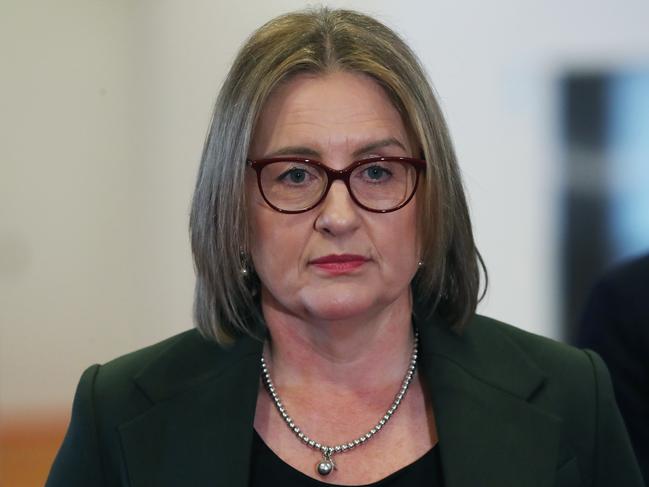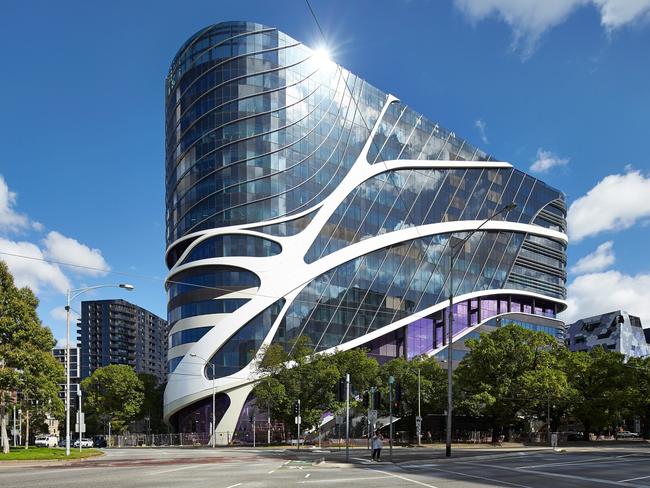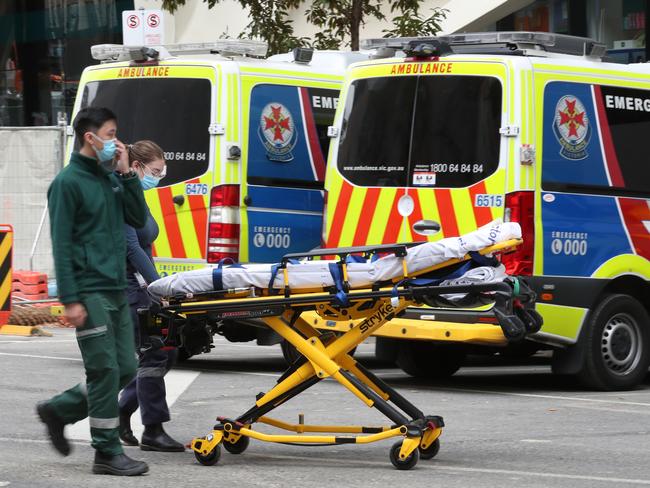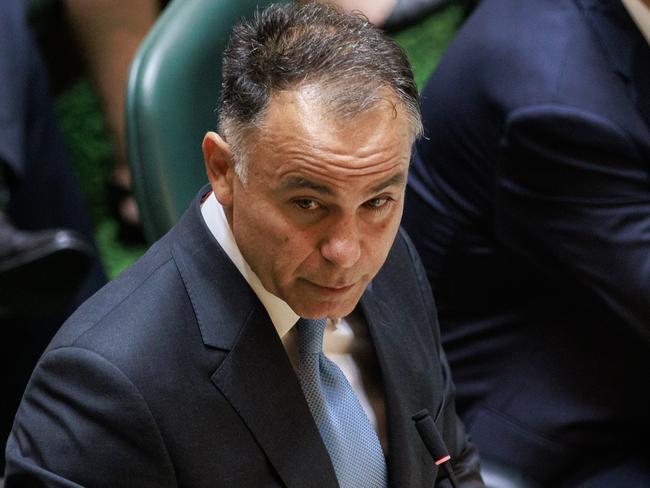Landmark report recommends Victorian health services be merged
The Allan government has been accused of bowing to political pressure in rejecting calls to amalgamate Victorian health services — but says it hasn’t ruled out the move in the future.
Victoria
Don't miss out on the headlines from Victoria. Followed categories will be added to My News.
The Allan government has been accused of bowing to political pressure in rejecting calls to amalgamate Victorian health services.
A highly anticipated Health Services Plan, made public on Thursday, called for forced amalgamations of health services as part of a total overhaul of the state’s health system.
The recommendation was the only one of 27 made to be rejected by the government, days after new polling revealed it was shedding voters because of its handling of the health crisis.
But it has not ruled out amalgamating services in the future, but has insisted any amalgamation would not be forced.
The government will, however, establish Local Health Service Networks to group health services together by geographical location in a move dubbed “amalgamation by stealth”.
Each network would include a major hospital, and links with tertiary, women’s, and children’s hospitals to “facilitate more consistent and effective connections with higher complexity care”.

While the government said they would reject the recommendation to forcibly merge hospitals, they accepted the report’s recommendation to group Victoria’s 76 health services into 11 networks, which will be required to work more closely together and share resources.
Under the proposal, health services in the same network would share administrative roles — such as payroll and IT — but also clinical, with networks to manage a single surgery waitlist for an entire area, as opposed to having queues of different lengths at different hospitals.
The report said networks would also be better able to redistribute patients between health services during busy times and share resources — including staff — across sites, with each network asked to create workforce banks for nursing, midwifery and allied health.
The committee said specialist hospitals — which some wanted to remain independent — should be included in networks as well, and recommended the Royal Children’s Hospital, Royal Melbourne Hospital, Royal Women’s Hospital and Peter MacCallum Cancer Centre form the Parkville network.
But they acknowledged this may be controversial, and proposed an alternative network — which they did not recommend — that kept the Royal Children’s Hospital by itself.
Each network will be linked to one Victoria’s five major tertiary hospitals — which can care for the most complex cases — and a children’s hospital and women’s hospital. If a local hospital patient’s condition deteriorated and they needed higher level care, that major tertiary hospital linked to their network would be required to admit them, or, if unable to, organise a bed for them at one of the four other major tertiary centres.

The government will also establish a hospital budget watchdog, Hospitals Victoria, which will be charged with keeping hospital finances in check.
It will also introduce an electronic medical record system to connect records between hospitals.
Health minister Mary-Anne Thomas guaranteed no frontline jobs or services would be cut as part of the statewide system overhaul.
However health sources who attended a Department of Health briefing on Thursday said there would be a renewed focus on cost savings to back office services.
Premier Jacinta Allan confirmed that back office jobs would be lost but was unable to say how many.
The announcement followed months of uncertainty and demands that hospitals slash more than $1bn from their budgets.
On Wednesday the government vowed to boost hospital budgets by $1.5bn over the next year in a move expected to simply reduce the size of new budget targets, not increase overall funding.

Senior government sources told the Herald Sun the money would be found through cuts to other government departments in a move deemed hugely unpopular with some ministers who had been asked to “sign up to selling a kidney” to fund the commitment.
The Victorian Healthcare Association welcomed the moves but said the reforms effectively amounted to clinical amalgamation.
VHA chief executive Leigh Clarke said: “with required network-wide consolidation of clinical activity and clinical management – this is centralising administration and resources across health services without immediately having to consolidate.”
Ms Clarke said she was pleased the government had listened to hospitals’ concerns, but said there would be more to unpack in the days ahead.
“Reform ... requires further consultation with stakeholders before embarking on any major changes, including health service employees, consumers and clinicians,” she said.
“The return of funding of $1.5bn is focused on avoiding the most significant of risks to clinical staff and services – and it seems there is no funding on the table to achieve system reform at this time.
“Secure and sustainable funding is needed to address the key enablers of reform such as filing workforce gaps with a skilled and mobile workforce and investing in good change management that minimises disruption such as loss of CEOs and other leaders.”

Jacinta Allan defended the government’s rejection of the recommendation to amalgamate hospitals saying it wasn’t in the best interest of patient care.
And she was unable to say how the government would fund its new $1.5bn commitment, saying that information would be available later this year as part of a budget update.
Polling released this week showed health was now a critical issue for the Allan government, with the ALP’s primary vote share dropping to 31 per cent, six points lower than the 37 it recorded at the 2022 election.
At the same time the Coalition’s primary vote increased to 40, its highest level since June 2021.
Once preferences of minor party voters are distributed, Labor and the Coalition would be tied 50-50 on a two-party preferred basis, according to the poll of 1514 Victorians.
Senior Labor sources said the polling had prompted serious concern among the government and could impact its approach to both health budgets and any potential services restructure.

The new Health Service Plan conceded the state’s health system was under “under increasing strain”, blaming the Covid-19 pandemic for that pressure.
“We have found many of these challenges are exacerbated by the system’s structure, with the siloed nature of Victoria’s health services creating obstacles to seamless, integrated patient care,” it said.
“Our precious health resources are not aligned to best meet the needs of patients now and into the future.
“Increasing demand for services and changing disease and demographic trends require integrated models of care that the current system is not designed to deliver.”
“The Health Services Plan represents a fundamental shift in how health care is structured and delivered in Victoria. Successfully implementing this change will depend on concerted and enduring effort from the department, health system leaders and workforce.”
Opposition Leader John Pesutto on Thursday criticised the government’s $1.5bn funding pledge as a “humiliating backdown”.
“(The government) has spent months and months causing distress to health services and communities right across Victoria, threatening amalgamation, demanding savage and brutal cuts to the delivery of health services for ill and sick Victorians,” he said.
“When the pressure got too much … it does an about face with no details.”
Opposition health spokeswoman Georgie Crozier said the “enormous backflip” demonstrated chaos and dysfunction within government.

Victorian Healthcare Association chief executive Leigh Clarke said while it welcomed the “urgent funding boost”, health services had already cut back of house staff and services.
“The government has listened to the concerns of services in light of the significant risks ahead to clinical staff and services,” she said.
“But the devil is always in the detail.
“We look forward to receiving more detail on the funding allocation afforded to services to ensure Victorian patients are not worse off.”
She said she was glad the government would not pursue large-scale and costly amalgamations.
“The VHA supports the intent of reform but recognises that now is not the time to be embarking on large-scale reform given the government’s commitment to paying down the state’s debt,” she said.
The Victorian Healthcare Association welcomed an end to the uncertainty, but noted the reforms effectively amounted to clinical amalgamation anyways and the government — despite announcing a $1.5bn top-up — was still “progressing measures to contain costs within the health budget”.
The government had last night ruled out forced mergers of hospitals, but on Thursday they announced they had accepted the report’s other recommendations, including ones which would see Victoria’s 76 health services grouped, by location, into 11 networks.
Networks recommended by the report
METROPOLITAN
Parkville*
• Royal Children’s
• Royal Women’s
• Royal Melbourne
• Peter MacCallum Cancer Centre
*Alternative, would leave Royal Children’s as a “standalone entity”.
West Metro
• Western Health Services
- Partnership with Mercy Werribee Hospital
North Metro
• Austin Health
• Northern Health
• Partnership with Mercy Hospital for Women
East Metro
• Eastern Health
• Royal Victorian Eye and Ear Hospital
• Dental Health Services
• Partnership with St Vincent’s Health
South Metro
• Monash Health
• West Gippsland Healthcare Group
Bayside
• Alfred Health
• Peninsula Health and Kooweerup Regional Health Service
• In partnership with Cavalry Health Care Bethlehem
REGIONAL
Barwon South West
• Barwon Health
• Casterton Memorial Hospital
• Colac Area Health
• Great Ocean Road Health
• Hesse Rural Health Service
• Heywood Rural Health
• Moyne Health Services
• Portland District Health
• South West Healthcare
• Terang and Mortlake Health Service
• Timboon and District Healthcare Service
• Western District Health Service
* alternative — proposed by the committee but considered “suboptimal” - splits network in two, into Barwon Network and South West Network
Grampians
• Beaufort & Skipton Health Service
• Central Highlands Rural Health (excluding Kyneton Hospital)
• East Grampians Health Service
• East Wimmera Health Service,
Grampians Health
• Maryborough District Health Service
• Rural Northwest Health
• West Wimmera Health Service
Loddon Mallee*
• Bendigo Health
• Boort District Health
• Cohuna District Hospital
• Dhelkaya Health
• Echuca Regional Health
• Heathcote Health
• Inglewood and Districts Health Service
• Kerang District Health
• Kyneton Hospital
• Mallee Track Health and Community Service,
• Mildura Base Public Hospital
• Robinvale District Health Services,
• Rochester & Elmore District Health Service
• Swan Hill District Health
* alternative — proposed by the committee but described as not their “preferred option” - splits network in two, into Mallee Network and Loddon Network
Hume
• Albury Wodonga Health
• Goulburn Valley Health
• Alexandra District Health
• Alpine Health
• Beechworth Health Service
• Benalla Health
• Corryong Health
• Euroa Health
• Kyabram District Health Service
• Mansfield District Hospital
• NCN Health
• Northeast Health Wangaratta
• Seymour Health
• Tallangatta Health Service
• Yarrawonga Health
• Yea and District Memorial Hospital
Gippsland
• Latrobe Regional Hospital
• Bairnsdale Regional Health Service
• Bass Coast Health
• Central Gippsland Health Service
• Gippsland Southern Health Service
• Omeo District Health
• Orbost Regional Health
• South Gippsland Hospital
• Yarram & District Health Service


